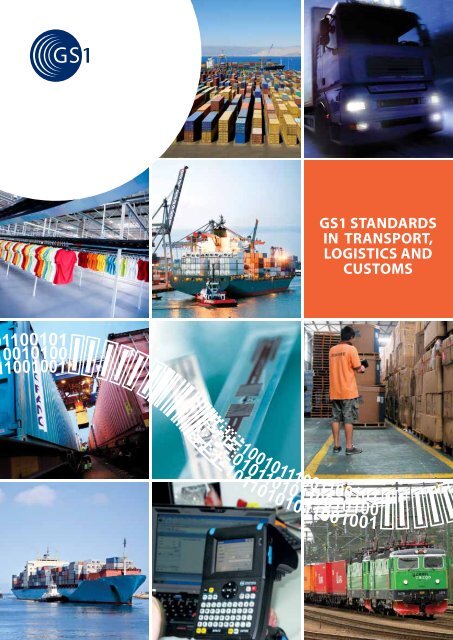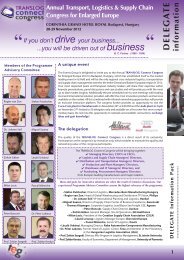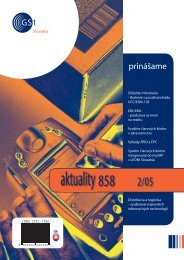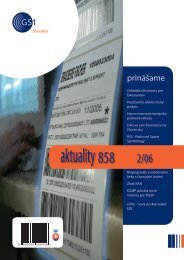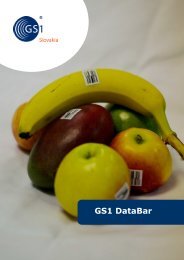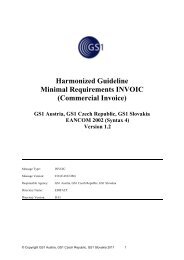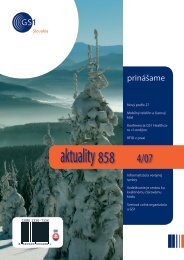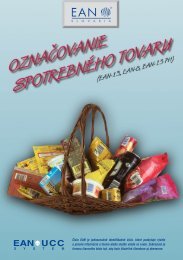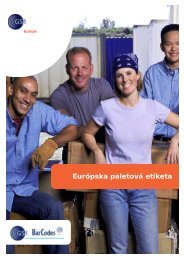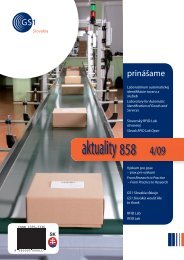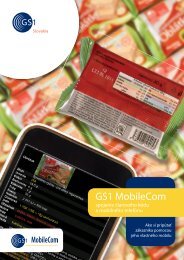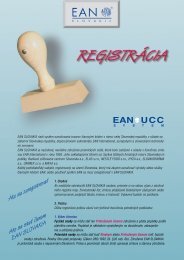GS1 StandardS in tranSport, LoGiSticS and cuStomS - GS1 Slovakia
GS1 StandardS in tranSport, LoGiSticS and cuStomS - GS1 Slovakia
GS1 StandardS in tranSport, LoGiSticS and cuStomS - GS1 Slovakia
You also want an ePaper? Increase the reach of your titles
YUMPU automatically turns print PDFs into web optimized ePapers that Google loves.
<strong>GS1</strong> St<strong>and</strong>ards<br />
<strong>in</strong> Transport,<br />
Logistics <strong>and</strong><br />
customs
KEEPING THE HEART OF<br />
INDUSTRY BEATING<br />
We are pleased to share with you a variety of success stories from transportation <strong>and</strong> logistics teams who have<br />
successfully used the <strong>GS1</strong> System of st<strong>and</strong>ards to face their challenges <strong>and</strong> meet their objectives.<br />
We would like to thank the follow<strong>in</strong>g for contribut<strong>in</strong>g to this second edition:<br />
Heide Buhl, <strong>GS1</strong> Germany / Mia Lenman, Alice Mukaru <strong>and</strong> Cecilia Gyldén , <strong>GS1</strong> Sweden / Jeff Chan, Eric<br />
Chow, <strong>GS1</strong> Hong Kong / Carrie Wen, James Perng, <strong>GS1</strong> Taiwan / Koji Asano, <strong>GS1</strong> Japan / Naotaka Ishizawa, NYK<br />
/ Rafael Flórez, Yara Montaña , <strong>GS1</strong> Colombia / Elzbieta Halas, Piotr Frąckowiak <strong>and</strong> Patrycja Gaj, <strong>GS1</strong> Pol<strong>and</strong> /<br />
Edyta Staszczyk, Raben Pol<strong>and</strong> / Lisa S<strong>and</strong>berg, Steve Arens, Susanna Valerius, <strong>GS1</strong> US / Jan Somers, Nicolas<br />
Stuyckens, <strong>GS1</strong> Belgium & Luxembourg / Douglas Bailey, US Department of Agriculture / Lennart Andersson,<br />
the Swedish Transport Adm<strong>in</strong>istration / Gunnar Ivansson, Learn<strong>in</strong>gWell<br />
Yuliya Shevchenko<br />
Group Manager, Transport & Logistics <strong>and</strong> Customs<br />
<strong>GS1</strong> Global Office<br />
Nora Kaci<br />
Market<strong>in</strong>g Manager, T&L <strong>and</strong> Customs<br />
<strong>GS1</strong> Global Office
Transport <strong>and</strong> Logistics (T&L) activities act as the<br />
ve<strong>in</strong>s <strong>and</strong> arteries of <strong>in</strong>dustry, keep<strong>in</strong>g the essential lifeblood<br />
of bus<strong>in</strong>ess flow<strong>in</strong>g <strong>and</strong> the heartbeat of commerce<br />
beat<strong>in</strong>g. T&L <strong>in</strong>volves complex bus<strong>in</strong>ess discipl<strong>in</strong>es<br />
that require <strong>in</strong>teractions between many different<br />
departments with<strong>in</strong> a bus<strong>in</strong>ess, as well as their partners,<br />
suppliers <strong>and</strong> customers. They have also become a hightechnology<br />
activity: a variety of transport <strong>and</strong> warehouse<br />
management technologies <strong>and</strong> software applications are<br />
now associated with the movement of goods from the<br />
material supplier to the manufacturer to the end customer.<br />
A large number of <strong>GS1</strong> st<strong>and</strong>ards have been developed so<br />
far, <strong>and</strong> the objective of our work is to facilitate adoption<br />
of these st<strong>and</strong>ards by supply cha<strong>in</strong> stakeholders. This will<br />
ultimately br<strong>in</strong>g both sav<strong>in</strong>gs to bus<strong>in</strong>ess operations <strong>and</strong><br />
benefits to their customers.<br />
How the <strong>GS1</strong> system of st<strong>and</strong>ards can help<br />
With <strong>GS1</strong> St<strong>and</strong>ards as the basis for their operations <strong>and</strong><br />
services, transportation <strong>and</strong> logistics teams can st<strong>and</strong>ardise<br />
<strong>in</strong>formation <strong>and</strong> automate its collection <strong>and</strong> this leads to<br />
much greater efficiency <strong>in</strong> transport <strong>and</strong> warehous<strong>in</strong>g.<br />
Us<strong>in</strong>g <strong>GS1</strong> St<strong>and</strong>ards means that you can be sure that<br />
the <strong>in</strong>formation about each part of the process is reliable.<br />
It gives much better visibility of goods throughout the<br />
supply cha<strong>in</strong>, <strong>in</strong>clud<strong>in</strong>g be<strong>in</strong>g able to track every stage<br />
<strong>and</strong> trace shipments back to their orig<strong>in</strong>. There is also<br />
much better security throughout every step of the process,<br />
which guards aga<strong>in</strong>st theft <strong>and</strong>, <strong>in</strong> some areas, this can also<br />
help with regulatory compliance.<br />
Adopt<strong>in</strong>g <strong>GS1</strong> st<strong>and</strong>ards has susta<strong>in</strong>ability benefits, s<strong>in</strong>ce<br />
improved efficiency <strong>in</strong> transportation means reduced CO2<br />
use <strong>and</strong> full traceability of goods ensures better social<br />
responsibility. F<strong>in</strong>ally, the improved efficiency ultimately<br />
leads to greater profitability, s<strong>in</strong>ce the right goods get to<br />
the right place at the right time.<br />
Improv<strong>in</strong>g supply cha<strong>in</strong> efficiency – <strong>GS1</strong> <strong>in</strong> T&L<br />
Bus<strong>in</strong>esses need to streaml<strong>in</strong>e costs, <strong>in</strong>crease revenue<br />
streams, comply with legislation. Companies that<br />
provide logistic services can significantly reduce shippers’<br />
spend<strong>in</strong>g on goods warehous<strong>in</strong>g <strong>and</strong> transportation. By<br />
adopt<strong>in</strong>g <strong>GS1</strong> St<strong>and</strong>ards, the efficiency <strong>and</strong> visibility of T&L<br />
operations of supply cha<strong>in</strong> stakeholders can be improved.<br />
<strong>GS1</strong> T&L Industry User Group<br />
<strong>GS1</strong> has established the T&L Industry User Group (IUG),<br />
a voluntary group consist<strong>in</strong>g of manufacturers, retailers,<br />
<strong>and</strong> logistics solution providers from across the globe, to<br />
lead <strong>and</strong> implement <strong>GS1</strong> Global st<strong>and</strong>ards <strong>in</strong> Transport<br />
& Logistics. By work<strong>in</strong>g with this user group we can be<br />
certa<strong>in</strong> that we are tackl<strong>in</strong>g the issues <strong>and</strong> challenges that<br />
really matter to <strong>in</strong>dustry.<br />
With <strong>GS1</strong>’s voluntary, user-designed st<strong>and</strong>ards, companies<br />
<strong>in</strong> the transportation <strong>and</strong> logistics sector can work more<br />
efficiently, more economically, more susta<strong>in</strong>ably <strong>and</strong><br />
more competitively <strong>and</strong> we are delighted to share with<br />
you, <strong>in</strong> this brochure, a variety of success stories from<br />
transportation <strong>and</strong> logistics teams who have successfully<br />
used the <strong>GS1</strong> System of st<strong>and</strong>ards to face their challenges<br />
<strong>and</strong> meet their objectives.<br />
Get started on your own success story! Learn more about<br />
<strong>GS1</strong> St<strong>and</strong>ards <strong>in</strong> the transportation <strong>and</strong> logistics sector at<br />
www.gs1.org/transportlogistics <strong>and</strong> then contact the <strong>GS1</strong><br />
Member Organisation <strong>in</strong> your country<br />
www.gs1.org/contact to f<strong>in</strong>d out how our st<strong>and</strong>ards can<br />
help your bus<strong>in</strong>ess.<br />
3
<strong>GS1</strong> St<strong>and</strong>ards Help<br />
Government <strong>and</strong> Industry<br />
Work Smarter<br />
Collaborat<strong>in</strong>g for Better Product Admissions<br />
at International Borders<br />
Imag<strong>in</strong>e the responsibility of protect<strong>in</strong>g the 300 million<br />
citizens <strong>in</strong> the U.S. from unsafe consumer products.<br />
U.S. government agencies screen millions of product<br />
shipments arriv<strong>in</strong>g at U.S. borders each year. They must<br />
make prompt <strong>and</strong> well-<strong>in</strong>formed decisions to admit or<br />
deny entry.<br />
Service (FSIS), the Consumer Product Safety Commission<br />
(CPSC), <strong>and</strong> the Environmental Protection Agency (EPA)<br />
each have the primary mission of protect<strong>in</strong>g the public<br />
from unsafe or high-risk products. “But the absence of a<br />
st<strong>and</strong>ards-based product classification <strong>and</strong> identification<br />
system has limited their ability to screen <strong>and</strong> admit<br />
products,” says PIC Chairman Doug Bailey. “With greater<br />
visibility <strong>in</strong>to product shipments, <strong>in</strong>spectors can make<br />
quicker <strong>and</strong> confident decisions. They can better manage<br />
the risk of imports for citizens <strong>and</strong> speed products through<br />
po<strong>in</strong>ts of entry for <strong>in</strong>dustry.”<br />
S<strong>in</strong>ce 2008, Bailey has worked with the meat <strong>and</strong> poultry<br />
<strong>in</strong>dustry to evaluate global product classification codes<br />
<strong>and</strong> their value for its supply cha<strong>in</strong>. “The light bulb<br />
immediately came on for me. <strong>GS1</strong> global st<strong>and</strong>ards are<br />
enabl<strong>in</strong>g supply cha<strong>in</strong> priorities like traceability. Why<br />
not use them to ga<strong>in</strong> the needed visibility for imported<br />
products?”<br />
Although <strong>in</strong>spectors have been traditionally challenged<br />
by the volume of imports, tighten<strong>in</strong>g federal government<br />
budgets <strong>in</strong> the U.S. <strong>and</strong> around the globe suggest that<br />
future government success may well depend on f<strong>in</strong>d<strong>in</strong>g<br />
new strategies for manag<strong>in</strong>g the admissions process. To<br />
address this <strong>in</strong>terest, federal government agencies <strong>in</strong> the<br />
U.S. International Trade Data System (ITDS) created the<br />
Product Information Committee (PIC) to explore ways to<br />
utilize additional <strong>in</strong>formation to improve the efficiency<br />
<strong>and</strong> effectiveness of product admissions at <strong>in</strong>ternational<br />
borders.<br />
The Need for Visibility<br />
Agencies like the Department of Health <strong>and</strong> Human<br />
Services’ Food <strong>and</strong> Drug Adm<strong>in</strong>istration (FDA), the United<br />
States Department of Agriculture’s Food Safety Inspection<br />
The Strength of <strong>GS1</strong> St<strong>and</strong>ards<br />
In the U.S., <strong>GS1</strong> US has established a strong collaboration<br />
with the ITDS participat<strong>in</strong>g government agencies <strong>and</strong> the<br />
U.S. Customs Service to facilitate cross-border trade via<br />
<strong>GS1</strong> St<strong>and</strong>ards. In December 2010, the ITDS PIC released its<br />
report “Guidance for Us<strong>in</strong>g E-Commerce Data to Manage<br />
Product Admission at International Borders,” propos<strong>in</strong>g<br />
the voluntary use of <strong>GS1</strong> St<strong>and</strong>ards <strong>and</strong> UN st<strong>and</strong>ards<br />
by <strong>in</strong>dustry for greater visibility with product data. The<br />
report provides government <strong>and</strong> <strong>in</strong>dustry with three basic<br />
recommendations:<br />
• <strong>GS1</strong> Global Product Classification (GPC) <strong>and</strong> the<br />
United Nations St<strong>and</strong>ard Products <strong>and</strong> Services<br />
Codes (UNSPSC) : The importer can use global product<br />
classification codes such as the GPC brick <strong>and</strong> the United<br />
Nations St<strong>and</strong>ard Products <strong>and</strong> Services Codes (UNSPSC)<br />
to extend product descriptions beyond the tariff code.<br />
The <strong>GS1</strong> GPC system <strong>and</strong> UNSPSC provide a common,<br />
global language for group<strong>in</strong>g products <strong>in</strong> the same way.<br />
These codes can help government quickly determ<strong>in</strong>e<br />
jurisdictional responsibility <strong>and</strong> assess the general nature<br />
of product risk. And if GPC brick descriptors are used <strong>in</strong><br />
addition to the brick code, product risk factors are even<br />
more precisely communicated.
• <strong>GS1</strong> Global Trade Item Number® (GTIN®): The<br />
importer can use the GTIN whenever possible to identify<br />
each product <strong>in</strong> a shipment. This allows government to<br />
manage products by br<strong>and</strong> <strong>and</strong> model number, not just<br />
product type, <strong>and</strong> reuse previous admission decisions to<br />
dramatically improve efficiency.<br />
• <strong>GS1</strong> Global Data Synchronization Network<br />
(GDSN®): The use of product <strong>in</strong>formation <strong>in</strong> the<br />
GDSN creates additional efficiencies for <strong>in</strong>dustry <strong>and</strong><br />
government. If product suppliers have published – one<br />
time only – its products’ GTINs <strong>and</strong> associated product<br />
<strong>in</strong>formation <strong>in</strong>to <strong>GS1</strong> GDSN data pools, government can<br />
access this authoritative product <strong>in</strong>formation as a “cloud”<br />
service. Importers only need to provide the product GTIN<br />
at the time of import, <strong>and</strong> the government can tap <strong>in</strong>to<br />
the product <strong>in</strong>formation stored <strong>in</strong> GDSN, <strong>in</strong>clud<strong>in</strong>g the<br />
GPC brick <strong>and</strong> attribute codes, to make <strong>in</strong>formed decisions<br />
about products, particularly those with complex risk<br />
factors.<br />
In summary, the government can reuse GDSN-stored<br />
product <strong>in</strong>formation, as needed, to make quick <strong>and</strong><br />
knowledgeable decisions about product risk. Enhanced<br />
risk management means improved public <strong>and</strong><br />
environmental safety. Government can also use product<br />
GTINs to reuse previous admissions decisions, which<br />
delivers new levels of efficiency <strong>and</strong> productivity.<br />
In turn, highly productive <strong>in</strong>spectors expedite <strong>and</strong> improve<br />
the predictability of product movement for suppliers <strong>and</strong><br />
importers. Expedited shipments lead to quicker time-toshelf<br />
<strong>in</strong>tervals <strong>and</strong> <strong>in</strong>creased revenue for suppliers <strong>and</strong><br />
retailers.<br />
The Significance of Global Reach<br />
<strong>GS1</strong> St<strong>and</strong>ards address government <strong>and</strong> <strong>in</strong>dustry<br />
challenges worldwide based on their global reach <strong>and</strong><br />
broad acceptance.<br />
• <strong>GS1</strong> St<strong>and</strong>ards are used broadly throughout the global<br />
supply cha<strong>in</strong> – by suppliers, distributors, retailers <strong>and</strong><br />
operators that span multiple <strong>in</strong>dustry sectors.<br />
• Over 6.5 million GTINs are registered by 21,000 trad<strong>in</strong>g<br />
partners from 131 participat<strong>in</strong>g countries <strong>in</strong> the <strong>GS1</strong> Global<br />
Data Synchronization Network, <strong>and</strong> product publication is<br />
exp<strong>and</strong><strong>in</strong>g at a pace of about 1 million GTINs a year.<br />
• <strong>GS1</strong> St<strong>and</strong>ards have been developed with <strong>in</strong>put,<br />
feedback <strong>and</strong> consensus from <strong>in</strong>dustry.<br />
• About one-third to over one-half of all products <strong>in</strong> trade<br />
are identified with <strong>GS1</strong> GTINs. They will allow government<br />
to manage this segment of trade by br<strong>and</strong> <strong>and</strong> model<br />
number, not just by product type when only the tariff code<br />
is available.<br />
The Value of Voluntary Action<br />
The ITDS Product Information Committee recommends<br />
the use of e-commerce data by <strong>in</strong>dustry be voluntary. To<br />
better underst<strong>and</strong> what’s needed <strong>and</strong> the actual value on<br />
real-world transactions, the PIC is conduct<strong>in</strong>g three pilots<br />
focused on high-risk products – toys, meat <strong>and</strong> poultry,<br />
<strong>and</strong> flowers.<br />
One pilot features the Association of Floral Importers<br />
of Florida (AFIF) work<strong>in</strong>g with the U.S. Customs Service<br />
to leverage GTINs <strong>and</strong> UNSPSC codes to expedite import<br />
<strong>in</strong>spections. “Over 87 percent of all floral imports come<br />
through Miami on airl<strong>in</strong>es,” says Christ<strong>in</strong>e Boldt, executive<br />
vice president of the AFIF. “Every shipment must be<br />
<strong>in</strong>spected, <strong>and</strong> boxes on the shipment are targeted based<br />
on their levels of risk for <strong>in</strong>festation. The <strong>in</strong>spection process<br />
is entirely done by pen <strong>and</strong> paper.”<br />
In the pilot, participat<strong>in</strong>g suppliers are us<strong>in</strong>g GTINs on<br />
boxes to <strong>in</strong>dicate flower types <strong>and</strong> countries of orig<strong>in</strong>. The<br />
GTINs are also listed on the <strong>in</strong>voice forwarded to importers.<br />
“Importers <strong>in</strong>put the GTINs <strong>in</strong>to the Customs’ system,”<br />
describes Boldt.<br />
5
“When the agricultural <strong>in</strong>spectors walk <strong>in</strong>to the airl<strong>in</strong>e<br />
facility, they have a pr<strong>in</strong>t out of the GTINs from the system<br />
<strong>and</strong> simply match them to the GTINs on the boxes. With<br />
the added product <strong>in</strong>formation, they can easily <strong>and</strong> quickly<br />
target high-risk boxes for <strong>in</strong>spections.”<br />
To date, the value of the pilot for importers <strong>and</strong> the<br />
government is clear: sav<strong>in</strong>g significant time by mov<strong>in</strong>g<br />
from a tedious, manual process to one that is expeditious<br />
<strong>and</strong> automated. Optimistic about the pilot’s f<strong>in</strong>al results,<br />
Boldt concludes, “With <strong>GS1</strong> St<strong>and</strong>ards, I’m confident we<br />
can reduce the <strong>in</strong>spection time by at least 50 percent.<br />
And ultimately, with further collaboration <strong>and</strong> the use of<br />
technology such as barcode scanners, we can ga<strong>in</strong> even<br />
greater reductions.”<br />
• Share these concepts with your company’s “U.S.<br />
Customs manager” <strong>and</strong> Customs managers at the borders<br />
where you conduct bus<strong>in</strong>ess.<br />
• Discover the potential value for your company. Contact<br />
Doug Bailey at douglas.bailey@ams.usda.gov to see if a<br />
pilot can be started for products with strategic value for<br />
your company.<br />
With cont<strong>in</strong>ued collaboration, <strong>GS1</strong>, governments, <strong>and</strong><br />
<strong>in</strong>dustries together can build a smarter global logistics<br />
process, enabl<strong>in</strong>g governments to efficiently manage the<br />
grow<strong>in</strong>g volume of <strong>in</strong>ternational trade.<br />
Get Engaged<br />
Suppliers, importers, <strong>and</strong> governments can get <strong>in</strong>volved<br />
to explore the value of work<strong>in</strong>g smarter for better product<br />
admissions at <strong>in</strong>ternational borders.<br />
• Learn more by read<strong>in</strong>g the PIC reports, “Leverag<strong>in</strong>g<br />
E-Commerce Product Data for Smarter Cargo<br />
Management” (April 2009) <strong>and</strong> “Guidance for Us<strong>in</strong>g<br />
E-Commerce Data to Manage Product Admission at<br />
International Borders.” Both reports are available at<br />
www.itds.gov.<br />
For more <strong>in</strong>formation contact:<br />
Steve Arens at sarens@gs1us.org
Smooth<strong>in</strong>g The Way For<br />
Goods Through Customs<br />
Labour Intensive Processes<br />
More than 1.2 million transhipped conta<strong>in</strong>ers are<br />
temporarily stored at the Port of Kaohsiung every year <strong>and</strong><br />
with five conta<strong>in</strong>er centres at the Port, all of which are at<br />
various locations <strong>in</strong> the city, smuggl<strong>in</strong>g was common even<br />
with a human escort.<br />
Prior to adopt<strong>in</strong>g EPC/RFID process<strong>in</strong>g of <strong>in</strong>-transit<br />
conta<strong>in</strong>ers relied on paper-based systems <strong>and</strong> this was<br />
very labour <strong>in</strong>tensive. Around 40,000 to 50,000 of these<br />
conta<strong>in</strong>ers have to be <strong>in</strong>spected every year <strong>and</strong> r<strong>and</strong>om<br />
<strong>in</strong>spections used to be performed automatically by a<br />
dynamic conta<strong>in</strong>er audit system.<br />
Each transport firm had to pay approximately USD<br />
$600,000 annually for escort services <strong>and</strong> escort<strong>in</strong>g one<br />
conta<strong>in</strong>er could take between 4 to 10 hours. Due to the<br />
problems with crim<strong>in</strong>al activity it was considered vital<br />
to implement EPC/RFID, which meets the requirement<br />
of WCO SAFE (Framework of St<strong>and</strong>ards to Secure <strong>and</strong><br />
Facilitate the Global Trade), as a matter of urgency.<br />
Putt<strong>in</strong>g EPC <strong>in</strong>to operation at the Port of Kaohsiung,<br />
Taiwan (1)<br />
“In-transit Conta<strong>in</strong>er Escort Exemption Program at the Port<br />
of Kaohsiung” was funded by the M<strong>in</strong>istry of Economics<br />
Affaires, Taiwan <strong>and</strong> <strong>in</strong>volved the EPC/RFID solution to<br />
replace human escort. This implemented dur<strong>in</strong>g the<br />
period 2006 to 2008 <strong>and</strong> s<strong>in</strong>ce 2010 all <strong>in</strong>ternational ports<br />
<strong>in</strong> Taiwan have been required to adopt it.<br />
With this programme each conta<strong>in</strong>er has an eSeal attached<br />
onto its door frame. Every entry of the conta<strong>in</strong>er centre<br />
has a reader po<strong>in</strong>t <strong>and</strong> was equipped with EPCglobal<br />
compliance readers.<br />
The system had to have the follow<strong>in</strong>g requirements:<br />
• use the EPC C1 Gen2 st<strong>and</strong>ard.<br />
• have a maximum read<strong>in</strong>g distance of 7 meters.<br />
• when vehicles <strong>in</strong> motion pass an <strong>in</strong>spection station at a<br />
speed of 60 km/h, the system must have a read<strong>in</strong>g rate of<br />
at least 95% with<strong>in</strong> 200 ms.<br />
• must be able to read all types of EPC eSeals <strong>in</strong> spite of<br />
different seal locations <strong>and</strong> variations <strong>in</strong> metal background.<br />
• the outdoor environment at the Port of Kaohsiung is<br />
hot, damp, <strong>and</strong> highly sal<strong>in</strong>e, <strong>and</strong> is subject to typhoons.<br />
Exist<strong>in</strong>g RFID hardware must enable the system to<br />
ma<strong>in</strong>ta<strong>in</strong> 24-hour operations throughout the year.<br />
• the system must achieve a high level of reliability<br />
<strong>and</strong> be connected <strong>and</strong> completely compatible with<br />
the Kaohsiung Harbour Bureau’s exist<strong>in</strong>g onl<strong>in</strong>e image<br />
identification system.<br />
EPCIS - Customs data exchange (2)<br />
EPCIS collects conta<strong>in</strong>er transport <strong>in</strong>formation among<br />
Taiwan’s ma<strong>in</strong> ports. The Directorate General of Customs,<br />
Taiwan, is the first customs sector <strong>in</strong> the world to own the<br />
EPCIS. The next step will be to<br />
extend the implementation of<br />
the system <strong>in</strong> order to improve<br />
cross-border cooperation <strong>and</strong><br />
customs <strong>in</strong>formation shar<strong>in</strong>g<br />
among different countries.<br />
Escort, export, transhipped <strong>and</strong> 1<br />
import conta<strong>in</strong>er <strong>in</strong>formation<br />
can all be generated <strong>and</strong><br />
exchanged <strong>in</strong> multiple EPCIS<br />
which provides visibility for<br />
customs, encourages EPC/RFID<br />
adoption <strong>in</strong> conta<strong>in</strong>er transport<br />
among Asia countries <strong>and</strong> 2<br />
facilitates Green Lane policy.<br />
A Clear Route To Efficiency<br />
(3)<br />
The new customs system<br />
at Port of Kaohsiung has a<br />
number of clear, demonstrable<br />
3<br />
benefits, most notably:<br />
• The labour <strong>in</strong>tensive requirement for people to<br />
escort conta<strong>in</strong>ers has been significantly reduced; by<br />
approximately 10,000 trips <strong>in</strong> escort operations of<br />
<strong>in</strong>-transit conta<strong>in</strong>ers <strong>and</strong> 4,000 trips <strong>in</strong> <strong>in</strong>spections for<br />
<strong>in</strong>l<strong>and</strong> transshipment, per year;<br />
• Improvement <strong>in</strong> overall customs efficiency;<br />
A reduction <strong>in</strong> around 48,000 hours per year <strong>in</strong> <strong>in</strong>spection<br />
for <strong>in</strong>-transit conta<strong>in</strong>er transport;<br />
• Conta<strong>in</strong>er vehicles can now pass through quickly<br />
without stopp<strong>in</strong>g;<br />
• A clear reduction <strong>in</strong> manpower <strong>and</strong> cost;<br />
• A sav<strong>in</strong>g, for the transport <strong>and</strong> logistics <strong>in</strong>dustry, of<br />
about USD$3,100,000 per year <strong>in</strong> relation to the previous<br />
cost of document review <strong>and</strong> customs clearance;<br />
• A much more robust approach to tackl<strong>in</strong>g smuggl<strong>in</strong>g<br />
<strong>and</strong> prevent<strong>in</strong>g cargo loss.<br />
For more <strong>in</strong>formation contact:<br />
Carrie Wen at carrie.wen@gs1tw.org<br />
7
Improved warehouse<br />
management at Sun Rise<br />
thanks to EPCIS<br />
Manag<strong>in</strong>g Global Logistics<br />
Sun Rise Management Limited (Sun Rise) is a logistics<br />
service provider established <strong>in</strong> Hong Kong <strong>in</strong> 1999. The<br />
company provides warehouse, cargo transportation <strong>and</strong><br />
haulage services to enterprises <strong>in</strong> the apparel, food, home<br />
appliance <strong>and</strong> raw materials <strong>in</strong>dustries around the world.<br />
The company operates a warehouse with 30,000 square<br />
feet <strong>in</strong> Yuen Long, Hong Kong.<br />
Key Benefits<br />
- Facilitat<strong>in</strong>g case <strong>and</strong> item-level stock-out<br />
With the EPC/RFID-based WMS on ezTRACK, Sun Rise<br />
can effectively locate <strong>and</strong> identify <strong>in</strong>ventory, not only on<br />
the case level but also on the item-level, <strong>and</strong> manage it<br />
based on the <strong>in</strong>dividual logistics requirements of each<br />
client. For one customer, which manufactures backpacks,<br />
the company can provide item level track<strong>in</strong>g for <strong>in</strong>dividual<br />
Overcom<strong>in</strong>g Inflexibility<br />
With customers spread out around the world, Sun Rise’s<br />
clients require the company to manage stock-<strong>in</strong>, stocktake<br />
<strong>and</strong> stock-out procedures of plastic particles <strong>and</strong><br />
backpacks based not only on product codes, but also<br />
specific batch numbers accord<strong>in</strong>g to their <strong>in</strong>dividual<br />
preferences. In addition, some clients require the company<br />
to manage <strong>in</strong>ventory down to the item level. Us<strong>in</strong>g<br />
manual procedures, Sun Rise’s warehouse operations<br />
were prone to human error <strong>and</strong> did not have the flexibility<br />
to cope with each client’s <strong>in</strong>dividual preferences. “Our<br />
ma<strong>in</strong> objective was to enhance warehouse efficiency by<br />
m<strong>in</strong>imiz<strong>in</strong>g human error. We wanted to achieve this by<br />
deploy<strong>in</strong>g the latest <strong>in</strong>formation technology solutions,”<br />
said Mr Kwok Fai, Founder of Sun Rise.<br />
Sun Rise decided to implement an EPC/RFID-based<br />
warehouse management system (WMS) based on the<br />
ezTRACK platform. The system was designed accord<strong>in</strong>g<br />
to the company’s logistics workflow <strong>and</strong> operations, which<br />
<strong>in</strong>cludes stock-<strong>in</strong> <strong>and</strong> stock-out procedures customized for<br />
each client’s <strong>in</strong>dividual needs. The data collected dur<strong>in</strong>g<br />
stock-<strong>in</strong> <strong>and</strong> stock-out us<strong>in</strong>g RFID h<strong>and</strong>held readers was<br />
synchronized from the EPC/RFID-based WMS to ezTRACK<br />
platform to capture accurate, real-time <strong>in</strong>ventory data.<br />
With the system <strong>in</strong> place, Sun Rise was able to manage<br />
<strong>in</strong>ventory by manufacturer batch numbers <strong>and</strong> perform<br />
stock-out at both the case <strong>and</strong> item levels.<br />
backpacks dur<strong>in</strong>g the stock-out procedure whereas <strong>in</strong> the<br />
past it could only track cases of, for <strong>in</strong>stance, 10 backpacks.<br />
- Enabl<strong>in</strong>g proof-of-delivery <strong>and</strong> elim<strong>in</strong>at<strong>in</strong>g returns<br />
“With the use of the EPC/RFID-based WMS on <strong>GS1</strong> Hong<br />
Kong’s ezTRACK platform, we have enhanced the<br />
flexibility <strong>and</strong> efficiency of our warehouse management<br />
process. More importantly, we have an accurate <strong>and</strong><br />
efficient delivery process that allows us to raise customer<br />
satisfaction,” said Mr. Kwok.<br />
ezTRACK: EPCIS st<strong>and</strong>ard traceability network,<br />
developed by <strong>GS1</strong> Hong Kong, enabl<strong>in</strong>g real<br />
time visibility of goods <strong>and</strong> <strong>in</strong>formation flow from<br />
po<strong>in</strong>t of manufactur<strong>in</strong>g to po<strong>in</strong>t of dest<strong>in</strong>ation<br />
The company is also able to provide real-time proof-ofdelivery,<br />
which <strong>in</strong> turn will reduce or elim<strong>in</strong>ate costly<br />
returns. “As a logistics service provider, we believe it is<br />
vital to fulfill each of our client’s <strong>in</strong>dividual requirements<br />
for stock management to rema<strong>in</strong> competitive. With the<br />
flexibility of the EPC/RFID-based WMS, we are now fully<br />
equipped to do so,” he added.<br />
For more <strong>in</strong>formation contact:<br />
Jeff Chan at jeffchan@gs1hk.org
Efficiency <strong>and</strong> accuracy <strong>in</strong><br />
stock management at<br />
Earnward Warehouse Limited<br />
Streaml<strong>in</strong><strong>in</strong>g Logistics<br />
Earnward Warehouse Limited (EWL) was founded <strong>in</strong> Hong<br />
Kong <strong>in</strong> 1991, with 10,000 square feet <strong>in</strong> warehouse space.<br />
S<strong>in</strong>ce then, the company has grown rapidly <strong>and</strong> is now<br />
a logistics service provider with a 180,000-square-feet<br />
warehouse facility <strong>in</strong> Kwai Chung, Hong Kong. Through<br />
exp<strong>and</strong><strong>in</strong>g its operations <strong>in</strong> Ma<strong>in</strong>l<strong>and</strong> Ch<strong>in</strong>a, the company<br />
also operates a warehouse with 200,000 square feet <strong>in</strong><br />
Guangdong, Ma<strong>in</strong>l<strong>and</strong> Ch<strong>in</strong>a.<br />
Challenges<br />
EWL provides warehouse facilities for a variety of<br />
manufacturers <strong>and</strong> suppliers to store a large number<br />
of goods with various delivery lead times. Its facility<br />
<strong>in</strong> the Ch<strong>in</strong>a Aviation Logistics Centre <strong>in</strong> Kwai Chung<br />
stores more than 1,000 mattresses for a lead<strong>in</strong>g bedd<strong>in</strong>g<br />
company. Similar to other logistics service providers, EWL<br />
was manag<strong>in</strong>g its warehouse <strong>and</strong> <strong>in</strong>ventory operations<br />
manually. Without a holistic<br />
<strong>in</strong>ventory track<strong>in</strong>g process, EWL<br />
had to manually record the exact<br />
location of each mattress <strong>and</strong><br />
locate the correct mattress dur<strong>in</strong>g<br />
the stock-out process. This led to<br />
a high rate of human error when<br />
fulfill<strong>in</strong>g orders, which resulted<br />
<strong>in</strong> costly shipment delays <strong>and</strong> an<br />
<strong>in</strong>ability to meet delivery schedules.<br />
Solution<br />
In order to enhance the efficiency of stock tak<strong>in</strong>g <strong>and</strong><br />
accuracy of stock-out procedures for the mattresses,<br />
EWL decided to deploy an EPC/RFID-based warehouse<br />
management system (WMS) <strong>in</strong> January 2010 <strong>and</strong> chose<br />
<strong>GS1</strong> Hong Kong’s ezTRACK platform, which is compliant<br />
with the globally recognized EPC St<strong>and</strong>ards.<br />
All the mattresses were assigned EPC-compliant RFID<br />
tags embedded with product <strong>in</strong>formation. All operational<br />
procedures for manag<strong>in</strong>g the mattresses, <strong>in</strong>clud<strong>in</strong>g the<br />
stock-<strong>in</strong> <strong>and</strong> stock-take processes, were performed us<strong>in</strong>g<br />
RFID h<strong>and</strong>held readers. The <strong>in</strong>formation collected from<br />
the reader was then transmitted to the EPC/RFID-based<br />
WMS, which synchronizes with the ezTRACK platform<br />
to enable product track<strong>in</strong>g <strong>and</strong> trac<strong>in</strong>g from any location<br />
at any time. To ensure the stockout process was 100%<br />
accurate, warehouse personnel were required to verify<br />
each mattress us<strong>in</strong>g a RFID h<strong>and</strong>held reader.<br />
For more <strong>in</strong>formation contact:<br />
Jeff Chan at jeffchan@gs1hk.org<br />
Key Benefits<br />
• Stock-out procedure 100% accurate<br />
The mattresses h<strong>and</strong>led by EWL are high value items, not<br />
easy to manually identify, <strong>and</strong> must be delivered accord<strong>in</strong>g<br />
to strict schedules. The EPC/RFID-based warehouse<br />
management system has helped the company to h<strong>and</strong>le<br />
these items more efficiently <strong>and</strong> to provide its client<br />
with more accurate delivery <strong>in</strong>formation, thus rais<strong>in</strong>g its<br />
st<strong>and</strong>ards of customer service.<br />
“The deployment of the EPC/RFID-based warehouse<br />
management system is prov<strong>in</strong>g to be most helpful to our<br />
warehouse operation. By elim<strong>in</strong>at<strong>in</strong>g human error from our<br />
procedures, we have successfully achieved 100% accuracy<br />
<strong>in</strong> shipments,” said Mr. Thomas Yau, IT Specialist, EWL,<br />
add<strong>in</strong>g that this has elim<strong>in</strong>ated costly stock returns.<br />
• Significant reduction <strong>in</strong> stock-take time<br />
With the use of RFID h<strong>and</strong>held readers, warehouse<br />
personnel can perform stock tak<strong>in</strong>g substantially faster.<br />
“With our previous warehouse management procedures,<br />
it took 48 hours to complete the stock-check<strong>in</strong>g process.<br />
Now, us<strong>in</strong>g the EPC/RFID-based WMS on the ezTRACK<br />
platform, the same task can be accomplished <strong>in</strong> half a day.<br />
We only need two personnel to h<strong>and</strong>le this task <strong>in</strong>stead of<br />
four. As a result, we can allocate our staff resources more<br />
efficiently <strong>and</strong> effectively when compared with manually<br />
monitor<strong>in</strong>g <strong>and</strong> identify<strong>in</strong>g stock,” said Mr. Yau.<br />
Overall, EWL’s EPC/RFID-based WMS resulted <strong>in</strong><br />
significantly quicker, more accurate <strong>and</strong> more efficient<br />
h<strong>and</strong>l<strong>in</strong>g of its client’s shipments. Through the power of<br />
real-time traceability, EWL also has full visibility of <strong>in</strong>ventory<br />
stored <strong>in</strong> its warehouse facility.<br />
9
Sweden takes the lead <strong>in</strong><br />
RFID st<strong>and</strong>ards for railways<br />
Early <strong>in</strong> 2011 goods wagons marked with RFID<br />
tags will start to roll <strong>in</strong> a full-scale test of between some of<br />
the Volvo’s facilities <strong>in</strong> Sweden <strong>and</strong> Belgium. This is a major<br />
step towards creat<strong>in</strong>g a common st<strong>and</strong>ard for identify<strong>in</strong>g<br />
<strong>and</strong> track<strong>in</strong>g roll<strong>in</strong>g stock throughout Europe.<br />
It is the Swedish Transport Adm<strong>in</strong>istration (previously the<br />
National Rail Adm<strong>in</strong>istration) that has been test<strong>in</strong>g RFFID<br />
solutions for many years. It all started with a system us<strong>in</strong>g<br />
active tags, but with the major drawback that they must<br />
be powered with batteries.<br />
“The solution we have ended up with is based on passive<br />
RFID tags that are activated by the radio signal from the<br />
reader. This is a new generation of tags that can be read<br />
even when the tra<strong>in</strong>s are runn<strong>in</strong>g at high speeds,” says<br />
Gunnar Ivansson, consultant at Learn<strong>in</strong>gwell who has<br />
helped to develop the technology.<br />
In order for the solution that Swedish Transport<br />
Adm<strong>in</strong>istration is test<strong>in</strong>g to be developed <strong>in</strong>to a European<br />
st<strong>and</strong>ard, <strong>GS1</strong>’s global st<strong>and</strong>ards for RFID are be<strong>in</strong>g used.<br />
Even the readers are st<strong>and</strong>ardized with a specific <strong>in</strong>terface.<br />
Lennart Andersson, who is responsible for the project<br />
at Swedish Transport Adm<strong>in</strong>istration, is pleased with<br />
the high level of <strong>in</strong>terest from all over Europe, “Swedish<br />
Transport Adm<strong>in</strong>istration was on <strong>GS1</strong>’s st<strong>and</strong> at the<br />
InnoTrans fair <strong>in</strong> Berl<strong>in</strong> last autumn <strong>and</strong> we made contact<br />
with about 70 people from a long list of countries. Many<br />
different solutions are be<strong>in</strong>g tested, but we want to drive<br />
development so that there will really be a European<br />
st<strong>and</strong>ard that everyone can use.”<br />
Operators <strong>in</strong> Sweden are also very keen that RFID<br />
technology is st<strong>and</strong>ardised so that it works outside<br />
Sweden, too, “60 per cent of our volume is <strong>in</strong>ternational,<br />
that is, it is <strong>in</strong> transit to or from Europe. Sweden lives<br />
by export<strong>in</strong>g, <strong>and</strong> transport is an important part of it,”<br />
says Michael Nysten, quality manager at Green Cargo, a<br />
company that h<strong>and</strong>les up to 60,000 loaded goods wagons<br />
each month.<br />
Green Cargo has <strong>in</strong>vested its own money <strong>in</strong> the trial, with<br />
Volvo Logistics’ transports from Olofström <strong>in</strong> the south of<br />
Sweden, “Keep<strong>in</strong>g track of roll<strong>in</strong>g stock us<strong>in</strong>g RFID tags is<br />
a simple <strong>and</strong> <strong>in</strong>expensive solution. We have tried to put a<br />
GPS on the wagons, <strong>and</strong> that gets expensive,” says Michael<br />
Nysten<br />
Nysten cont<strong>in</strong>ues,“It is a great advantage, not least for<br />
freight customers, to be able to go to a web portal <strong>and</strong><br />
easily access <strong>in</strong>formation about where the wagons <strong>and</strong><br />
goods are”. Nysten also believes that RFID technology<br />
will reduce adm<strong>in</strong>istration <strong>and</strong> paper h<strong>and</strong>l<strong>in</strong>g, <strong>in</strong>clud<strong>in</strong>g<br />
everyth<strong>in</strong>g from bill<strong>in</strong>g to report<strong>in</strong>g what has been done.<br />
Swedish Transport Adm<strong>in</strong>istration also foresees big ga<strong>in</strong>s<br />
with less adm<strong>in</strong>istration <strong>and</strong> improved <strong>in</strong>formation to<br />
customers, <strong>and</strong> <strong>in</strong> addition expects to reduce ma<strong>in</strong>tenance<br />
costs, “Goods wagons generate considerable wear <strong>and</strong><br />
tear on the rails, especially if they have any damage. Today,<br />
we have difficulty gett<strong>in</strong>g an overview of which wagons<br />
have problems, but with RFID, we can identify wagons <strong>and</strong><br />
take prompt action,” says Lennart Andersson. “We also get<br />
statistics that we can use for preventative ma<strong>in</strong>tenance.”<br />
Labell<strong>in</strong>g of wagons is carried out by the operators. There<br />
are two RFID tags on each wagon. Accord<strong>in</strong>g to Gunnar<br />
Ivansson the price has now dropped to about €3 per tag.<br />
It is Swedish Transport Adm<strong>in</strong>istration that sets up readers<br />
<strong>and</strong> runs the system, which it is then is up to operators<br />
to use. The tests now be<strong>in</strong>g carried out will provide<br />
<strong>in</strong>formation about what services will be <strong>in</strong> dem<strong>and</strong>.<br />
“The railways have always been good at f<strong>in</strong>d<strong>in</strong>g their<br />
own solutions <strong>in</strong> each country. We are now develop<strong>in</strong>g<br />
a st<strong>and</strong>ard that is common to all countries <strong>and</strong> which<br />
also can be used by other modes of transport,” Lennart<br />
Andersson concludes.<br />
When fully operational, it will be possible to follow a<br />
wagon through the whole of Europe us<strong>in</strong>g <strong>GS1</strong> global<br />
st<strong>and</strong>ards.<br />
For more <strong>in</strong>formation contact:<br />
Alice Mukaru at alice.mukaru@gs1.se
<strong>GS1</strong> Makes Port Operations<br />
Pla<strong>in</strong> Sail<strong>in</strong>g<br />
The Port of Gothenburg is us<strong>in</strong>g RFID technology<br />
to get <strong>in</strong>formation about rail transports to <strong>and</strong> from the<br />
port.<br />
The Port of Gothenburg is Sc<strong>and</strong><strong>in</strong>avia’s largest port <strong>and</strong><br />
for operations to run efficiently, early notification is needed<br />
on what to load <strong>and</strong> unload.<br />
“The world’s largest conta<strong>in</strong>er vessels call at the port <strong>and</strong> <strong>in</strong><br />
order to fill them we fetch shipments with rail shuttles from<br />
all over Sweden <strong>and</strong> Norway,” says Arvid Guthed, bus<strong>in</strong>ess<br />
developer at the port.<br />
As a prerequisite for the EU Dryport project, the Swedish<br />
Transport Adm<strong>in</strong>istration (STA) is now <strong>in</strong>stall<strong>in</strong>g readers<br />
on the stretch of track between the Port of Gothenburg<br />
<strong>and</strong> Falköp<strong>in</strong>g, <strong>in</strong> southwest Sweden where there is an<br />
<strong>in</strong>l<strong>and</strong> term<strong>in</strong>al. The next step will be for the wagons to<br />
be marked up by the tra<strong>in</strong> operators accord<strong>in</strong>g to <strong>GS1</strong><br />
st<strong>and</strong>ards for RFID. STA will then capture all the <strong>in</strong>formation<br />
when the wagons pass the RFID readers <strong>and</strong> put it out<br />
through a web <strong>in</strong>terface.<br />
More tra<strong>in</strong>s can be h<strong>and</strong>led<br />
“Advance <strong>in</strong>formation about a tra<strong>in</strong>’s composition as it<br />
arrives at the term<strong>in</strong>al allows us to pre-position units for<br />
load<strong>in</strong>g,” says Arvid Guthed. “This shortens the h<strong>and</strong>l<strong>in</strong>g<br />
time per tra<strong>in</strong> so we can take <strong>in</strong> more tra<strong>in</strong>s per day.”<br />
There are 26 rail shuttles that go between the various<br />
<strong>in</strong>l<strong>and</strong> term<strong>in</strong>als <strong>and</strong> the Port of Gothenburg, so there are<br />
huge volumes to manage.<br />
“Today, much of the report<strong>in</strong>g of what goods are bound<br />
for the port is done manually. There is a need to get early<br />
<strong>and</strong> correct <strong>in</strong>formation <strong>in</strong> an easier way. Everybody<br />
benefits from this,” says Per Sjöholm at Starbright<br />
Consult<strong>in</strong>g, technical project manager for the RFID project<br />
at the Port of Gothenburg.<br />
The Port of Gothenburg also sees RFID technology<br />
provid<strong>in</strong>g <strong>in</strong>creased potential for track <strong>and</strong> trace, that is<br />
l<strong>in</strong>k<strong>in</strong>g conta<strong>in</strong>er numbers to the wagon numbers.<br />
For more <strong>in</strong>formation contact:<br />
Cecilia Gyldén at cecilia.gylden@gs1.se<br />
11
Optimis<strong>in</strong>g The Textile Supply<br />
Cha<strong>in</strong> With <strong>GS1</strong> St<strong>and</strong>ards<br />
In 2009, Gerry Webber, a world-renowned<br />
cloth<strong>in</strong>g company took the decision to put <strong>in</strong>to place<br />
a ground break<strong>in</strong>g project for the entire <strong>in</strong>ternational<br />
supply cha<strong>in</strong>. They implemented EPC/RFID to optimise<br />
logistics procedures, processes <strong>in</strong> retail <strong>and</strong> at the same<br />
time they used it as a new form of retail security. Dur<strong>in</strong>g<br />
the development process a new <strong>in</strong>novation was also<br />
developed: the “normal” care label was extended to textile<br />
EPC/RFID tag comb<strong>in</strong><strong>in</strong>g functionality for anti-theft,<br />
manufacturer’s <strong>in</strong>struction for care <strong>and</strong> the Electronic<br />
Product Code.<br />
Increased Sales, More Channels<br />
The number of textile articles sold at Gerry Weber was<br />
cont<strong>in</strong>uously <strong>in</strong>creas<strong>in</strong>g every year <strong>and</strong> they also <strong>in</strong>creased<br />
the number of channels through which the products were<br />
sold. For this reason it became necessary to optimse the<br />
production <strong>and</strong> logistics processes at Gerry Weber but<br />
also at their stores <strong>and</strong> those operated by their franchise<br />
partners.<br />
The test phase with the new EPC/RFID system <strong>in</strong> Gerry<br />
Weber stores were so successful that <strong>in</strong> the meantime<br />
the solution has been implemented <strong>in</strong> all the HOUSES<br />
OF GERRY WEBER <strong>in</strong> Germany <strong>and</strong> abroad. More than 26<br />
million garments annually produced along the entire<br />
value cha<strong>in</strong> are equipped 2011 with EPC/RFID technology.<br />
Together with renowned partners <strong>in</strong>clud<strong>in</strong>g Meyer &<br />
Meyer, Deutsche Post DHL, Avery Dennison <strong>and</strong> Deutsche<br />
Telekom, Gerry Weber AG created a groundbreak<strong>in</strong>g<br />
project <strong>in</strong> the textile sector.<br />
Tackl<strong>in</strong>g The Issues<br />
Through the use of EPC/RFID technology, the follow<strong>in</strong>g<br />
issues where uncovered <strong>and</strong> resolved:<br />
1. The EPC/RFID-tags should be used as security tags that<br />
allow a large read<strong>in</strong>g distance so that the unattractive<br />
security equipment from the entrances of stores become<br />
redundant. At the same time the need to <strong>in</strong>stall separate<br />
anti-theft devices <strong>in</strong> logistics <strong>and</strong> remove them at the
checkout dur<strong>in</strong>g the payment process is elim<strong>in</strong>ated.<br />
This meant match<strong>in</strong>g up the EPC/RFID tags already <strong>in</strong><br />
production with the items, physically <strong>and</strong> logically. This<br />
also resulted <strong>in</strong> f<strong>in</strong>ancial benefits over the recent theft<br />
devices.<br />
2. With the possibility of bulk read<strong>in</strong>g, processes such<br />
as goods entry or <strong>in</strong>ventory record<strong>in</strong>g <strong>in</strong> stores or<br />
warehouses can be improved. These processes are prone<br />
to error, especially when carelessly implemented <strong>and</strong><br />
given the wide number of variants that are usually found<br />
<strong>in</strong> the textile <strong>in</strong>dustry. With the EPC/RFID technology,<br />
each textile article (piece of cloth<strong>in</strong>g), is allocated a s<strong>in</strong>gle<br />
serial number which can be read via radio waves. This<br />
enables quick <strong>and</strong> safe report<strong>in</strong>g <strong>and</strong> establishes the<br />
l<strong>in</strong>k to the production lot. The EPC/RFID tag label should<br />
be securely attached to the textile care label. It is also<br />
important that the tissue between the EPC/RFID tags does<br />
not affect the read<strong>in</strong>g rate.<br />
3. There were also challenges for the partners of Gerry<br />
Weber. The logistics service provider Meyer & Meyer, one<br />
of the lead<strong>in</strong>g service providers of textile logistics who<br />
h<strong>and</strong>les about 19 million textile items for Gerry Weber at<br />
different storage locations per year, took on the task of<br />
check<strong>in</strong>g the quality of EPC/RFID tags <strong>and</strong> replac<strong>in</strong>g them<br />
if necessary. This is the only way to ensure that 100 % of<br />
the articles are equipped with a readable tag <strong>in</strong> the store.<br />
For this purpose, Meyer & Meyer equipped barcode based<br />
systems h<strong>and</strong>l<strong>in</strong>g hang<strong>in</strong>g <strong>and</strong> ly<strong>in</strong>g garments with RFIDfunctionality<br />
to allow for a secure read<strong>in</strong>g of the EPC-tags<br />
(without affect<strong>in</strong>g the cycle times <strong>and</strong> avoid<strong>in</strong>g additional<br />
product separation activities).<br />
Benefits<br />
There have been a number of clear benefits to the new<br />
system, <strong>in</strong>clud<strong>in</strong>g:<br />
• Better control of deliveries of logistics service providers<br />
• Acceleration of returned deliveries<br />
• Faster process<strong>in</strong>g of <strong>in</strong>com<strong>in</strong>g goods <strong>and</strong> dispatch<br />
processes<br />
• Reduction of out-of-stock situations by provid<strong>in</strong>g better<br />
<strong>in</strong>ventory visibility<br />
• Faster <strong>and</strong> more accurate <strong>in</strong>ventories<br />
• Record<strong>in</strong>g of carton contents with<strong>in</strong> seconds<br />
The approaches of this project are transferable to other<br />
textile projects. The consistent use of <strong>GS1</strong> <strong>and</strong> EPCglobal<br />
st<strong>and</strong>ards is an important prerequisite for the efficient use<br />
of this new technology.<br />
In September 2010, Gerry Weber International<br />
AG <strong>and</strong> their project partners <strong>in</strong>clud<strong>in</strong>g Meyer & Meyer,<br />
Avery Dennison, Fiege, Hellmann, Deutsche Post<br />
DHL won the coveted German ECR-Award <strong>in</strong> the<br />
category Corporate Cooperation – Supply<br />
Side for successfully implement<strong>in</strong>g their<br />
<strong>in</strong>novative “EPC/RFID for the Textile Supply<br />
Cha<strong>in</strong>” project.<br />
For more <strong>in</strong>formation contact:<br />
Heide Buhl at buhl@gs1-germany.de<br />
13
<strong>GS1</strong> St<strong>and</strong>ards <strong>in</strong> Belgian Post<br />
Keep<strong>in</strong>g The Post On Track<br />
In 2009, bpost (Belgian Post) h<strong>and</strong>led more than 12 million<br />
mail items a day, of those, more than 90000 are national<br />
registered mail which means they conta<strong>in</strong> vital <strong>in</strong>formation<br />
for both the sender <strong>and</strong> addressee.<br />
Faced with the need to ensure that a postal item could<br />
be tracked from post office to f<strong>in</strong>al dest<strong>in</strong>ation <strong>in</strong>clud<strong>in</strong>g<br />
be<strong>in</strong>g aware of any <strong>in</strong>stance where the item does not<br />
arrive, bpost decided to <strong>in</strong>tegrate <strong>GS1</strong> st<strong>and</strong>ards <strong>in</strong><br />
E-Tracker, an onl<strong>in</strong>e solution enabl<strong>in</strong>g customers to trace,<br />
among other th<strong>in</strong>gs, national registered mails.<br />
Now bpost uses a certificate of post<strong>in</strong>g for registered<br />
mail that must be completed <strong>and</strong> kept by the client after<br />
be<strong>in</strong>g stamped by the Post Office. It carries a <strong>GS1</strong>-128 bar<br />
code pr<strong>in</strong>ted on a self-adhesive support, the upper part of<br />
which must be removed <strong>and</strong> affixed to the registered mail.<br />
The customer keeps the certificate of post<strong>in</strong>g, still bear<strong>in</strong>g<br />
the lower part of the same barcode. The Application<br />
Identifiers used <strong>in</strong> this case are AI (01) (GTIN of the product<br />
based upon bpost company prefix, <strong>in</strong> this case “national<br />
registered mail” <strong>and</strong> AI (21) (serial number of the national<br />
registered mail). GTIN <strong>and</strong> a serial number make each<br />
national registered mail unique.<br />
The issues of compatibility between commercial partners<br />
<strong>and</strong> compatibility with POS systems of the different<br />
retailers were one of the ma<strong>in</strong> challenges that had to<br />
be addressed. As <strong>GS1</strong> st<strong>and</strong>ards are already widely <strong>and</strong><br />
<strong>in</strong>ternationally spread <strong>in</strong> the retail environment, they were<br />
chosen to be sure that postal products <strong>and</strong> services could<br />
be scanned at the po<strong>in</strong>t of sale.<br />
Based on the bpost company prefix, Belgian postal stamps,<br />
parcels, post cards are therefore identified with a GTIN 13<br />
embedded <strong>in</strong> an EAN 13 barcode, open<strong>in</strong>g the path for<br />
further collaboration <strong>and</strong> open possibility of many other<br />
solutions between bpost <strong>and</strong> commercial partners.<br />
This works effectively for both parties. Bpost is able to<br />
track <strong>and</strong> trace the shipment from post office to delivery<br />
by scann<strong>in</strong>g the <strong>GS1</strong> barcode at each important po<strong>in</strong>t<br />
of the delivery process <strong>and</strong> the customer can follow the<br />
shipment <strong>and</strong> know at any time where its mail is by us<strong>in</strong>g<br />
a track <strong>and</strong> trace tool onl<strong>in</strong>e (E-TRACKER: www.bpost.be<br />
track). National registered mail has to be selected <strong>and</strong> the<br />
serial number encoded manually. The sender can check<br />
whether the national registered mail is still <strong>in</strong> transit or as<br />
already been received by recipient.<br />
St<strong>and</strong>ardisation Leads To Competitive Advantage<br />
In the context of <strong>in</strong>creased competition amongst<br />
postal service providers <strong>in</strong> Europe, bpost developed<br />
new solutions to enhance competitiveness, such as<br />
offer<strong>in</strong>g postal services or postal items outside the usual<br />
postal environment. A key development <strong>in</strong> this area<br />
was the open<strong>in</strong>g of “Po<strong>in</strong>t Poste/Postpunt” counters <strong>in</strong><br />
supermarkets <strong>and</strong> railway stations, s<strong>in</strong>ce this enabled the<br />
company to reach more <strong>and</strong> more customers.<br />
For more <strong>in</strong>formation contact:<br />
Nicolas Stuyckens at NStuyckens@gs1belu.org
Driv<strong>in</strong>g Efficiencies<br />
In Transport<br />
In Colombia, the transportation of goods takes<br />
up more than 37% of the logistics costs with<strong>in</strong> the supply<br />
cha<strong>in</strong>, which offers a great opportunity.<br />
The ma<strong>in</strong> problem we see, is the lack of on time <strong>and</strong><br />
reliable <strong>in</strong>formation between the customer, the third<br />
logistics party, <strong>and</strong> the driver. Even where it is available,<br />
it’s often very <strong>in</strong>formal <strong>and</strong> the <strong>in</strong>formation is frequently<br />
<strong>in</strong>complete. In order to develop better ways to <strong>in</strong>tegrate<br />
the <strong>in</strong>formation related to the different transport processes<br />
<strong>and</strong> to achieve on l<strong>in</strong>e visibility <strong>and</strong> traceability, <strong>GS1</strong><br />
Colombia def<strong>in</strong>ed <strong>and</strong> implemented an <strong>in</strong>tegrated<br />
platform that uses different technologies. These <strong>in</strong>clude;<br />
automatic global position<strong>in</strong>g systems for vehicles us<strong>in</strong>g<br />
GPS <strong>and</strong> GPRS technologies, mobile PC’s <strong>and</strong> EPC/RFID <strong>and</strong><br />
other <strong>in</strong>ternet based-solutions.<br />
The <strong>in</strong>itiative is be<strong>in</strong>g lead by a third logistics party called<br />
Almacenar - Almagran with the support of <strong>GS1</strong> Colombia<br />
<strong>and</strong> Solution Providers.<br />
In the traceability process 30 customers participated,<br />
<strong>in</strong>clud<strong>in</strong>g Falabella, Carrefour <strong>and</strong> Exito (the retail br<strong>and</strong><br />
of Cas<strong>in</strong>o <strong>in</strong> Colombia), their providers; Samsung <strong>and</strong> LG<br />
Electronics, 5 transportation enterprises <strong>and</strong> 150 drivers.<br />
<strong>GS1</strong> Colombia facilitated the implementation support<strong>in</strong>g<br />
the companies <strong>and</strong> the service providers.<br />
The new <strong>in</strong>tegrated platform has delivered<br />
significant benefits <strong>in</strong>clud<strong>in</strong>g:<br />
• A 50% sav<strong>in</strong>g <strong>in</strong> time <strong>in</strong> relation to the transportation<br />
processes<br />
• Sav<strong>in</strong>gs of 67% <strong>in</strong> communications costs due to less use<br />
of mobile phones<br />
• The <strong>in</strong>formation to be shared was set to a st<strong>and</strong>ard <strong>and</strong><br />
is available to all parties through one channel<br />
• Manual data <strong>in</strong>put was reduced; data was only <strong>in</strong>put<br />
once dur<strong>in</strong>g the whole process <strong>and</strong> this consolidated the<br />
<strong>in</strong>formation <strong>and</strong> avoided mistakes.<br />
• Much better visibility <strong>and</strong> traceability were developed <strong>in</strong><br />
all the processes.<br />
• Performance <strong>in</strong>dicators were calculated automatically.<br />
• Greater efficiency <strong>and</strong> diligence was achieved when<br />
assign<strong>in</strong>g <strong>and</strong> search<strong>in</strong>g for vehicles.<br />
• Many <strong>in</strong>efficiencies were elim<strong>in</strong>ated thus reduc<strong>in</strong>g costs<br />
<strong>and</strong> time.<br />
For more <strong>in</strong>formation contact:<br />
Yara Montana at ymontana@gs1co.org<br />
15
Japan’s Initiatives <strong>in</strong><br />
Supply Cha<strong>in</strong> Visibility<br />
The Challenge<br />
Many Japanese manufacturers have offshore production<br />
sites <strong>and</strong> trade around the world. However, s<strong>in</strong>ce they<br />
generally consign the cargo shipp<strong>in</strong>g associated with<br />
production <strong>and</strong> sales to other companies, it has been<br />
difficult for them to effectively manage the global<br />
supply cha<strong>in</strong>. To optimize the whole supply cha<strong>in</strong>, these<br />
manufacturers need to underst<strong>and</strong> the process <strong>in</strong> real time<br />
<strong>and</strong> take necessary measures <strong>in</strong> a timely manner, but a<br />
visibility platform to share cargo movement <strong>in</strong>formation<br />
among global supply cha<strong>in</strong> parties has not yet been<br />
established. Therefore, build<strong>in</strong>g such a visibility platform to<br />
capture the cargo movement around the world us<strong>in</strong>g <strong>GS1</strong><br />
EPCglobal st<strong>and</strong>ards is under consideration.<br />
In Japan, the movement to make the whole supply cha<strong>in</strong><br />
process visible us<strong>in</strong>g automatic identification technologies<br />
such as RFID has been accelerat<strong>in</strong>g among manufacturers<br />
for several years. The M<strong>in</strong>istry of Economy, Trade <strong>and</strong><br />
Industry (METI) held a study committee for global supply<br />
cha<strong>in</strong> visibility platform to foster this movement. At the<br />
same time, METI has also held Supply Cha<strong>in</strong> Visibility<br />
Workshop at <strong>in</strong>ternational conferences such as APEC<br />
(Asia-Pacific Economic Cooperation) <strong>and</strong> promoted<br />
the establishment of a visibility platform to share cargo<br />
movement <strong>in</strong>formation among global supply cha<strong>in</strong> parties.<br />
Cooperation with APEC<br />
When build<strong>in</strong>g a platform to share cargo movement<br />
<strong>in</strong>formation, it is crucial to adopt technologies based on<br />
<strong>in</strong>ternational st<strong>and</strong>ards <strong>and</strong> obta<strong>in</strong> agreement by the<br />
countries <strong>and</strong> <strong>in</strong>dustries <strong>in</strong>volved <strong>in</strong> its operation. METI<br />
organized a Supply Cha<strong>in</strong> Visibility workshop at the APEC<br />
meet<strong>in</strong>g <strong>in</strong> September 2010 <strong>in</strong> Sendai, Japan.<br />
At the beg<strong>in</strong>n<strong>in</strong>g of this workshop, METI discussed the<br />
importance <strong>and</strong> necessity of supply cha<strong>in</strong> visibility, <strong>and</strong><br />
then the various <strong>in</strong>dustries, governments, <strong>and</strong> <strong>in</strong>ternational<br />
st<strong>and</strong>ards organisations reported on their perspectives <strong>and</strong><br />
efforts.<br />
From the <strong>in</strong>dustries, global companies such as Canon,<br />
Toshiba, Oracle, IBM, DHL, <strong>and</strong> NYK L<strong>in</strong>e expressed their<br />
own corporate expectations for supply cha<strong>in</strong> visibility. At<br />
the same time, <strong>in</strong> addition to reports by the governments<br />
of Japan, Ch<strong>in</strong>a, Korea, Peru, Taiwan, Hong Kong, <strong>and</strong><br />
Russia, the European Commission (EC) <strong>in</strong>troduced their<br />
efforts toward supply cha<strong>in</strong> visibility. Regard<strong>in</strong>g the<br />
progress of <strong>in</strong>ternational st<strong>and</strong>ards organizations, the<br />
World Customs Organization (WCO), the United Nations<br />
Centre for Trade Facilitation <strong>and</strong> Electronic Bus<strong>in</strong>ess (UN/<br />
CEFACT), <strong>and</strong> <strong>GS1</strong> also expla<strong>in</strong>ed the related trends of<br />
st<strong>and</strong>ardisation. It was a highly significant workshop that<br />
deepened participants’ underst<strong>and</strong><strong>in</strong>g of supply cha<strong>in</strong><br />
visibility issues.<br />
Based on the outcome of this workshop, it was clearly<br />
stated <strong>in</strong> the Jo<strong>in</strong>t Statement of APEC M<strong>in</strong>isterial Meet<strong>in</strong>g<br />
that APEC would cont<strong>in</strong>ue to consider supply cha<strong>in</strong><br />
visibility at its meet<strong>in</strong>gs. As such, the movement toward<br />
supply cha<strong>in</strong> visibility is expected to accelerate <strong>in</strong> the APEC<br />
economies.<br />
At the meet<strong>in</strong>g, many countries <strong>and</strong> regions announced<br />
that they are consider<strong>in</strong>g the establishment of <strong>in</strong>formation<br />
platforms us<strong>in</strong>g EPCIS (EPC Information Services) of <strong>GS1</strong><br />
EPCglobal. The shar<strong>in</strong>g of cargo movement <strong>in</strong>formation<br />
us<strong>in</strong>g EPCIS will be achieved <strong>in</strong> the near future with<strong>in</strong> the<br />
APEC region.<br />
The Japanese Approach<br />
In Japan, a study committee for global supply cha<strong>in</strong><br />
visibility platform has been organised to consider <strong>and</strong><br />
promote the system of cargo <strong>in</strong>formation shar<strong>in</strong>g among<br />
companies (visibility platform) with the participation of<br />
academic experts, related organizations of shippers <strong>and</strong><br />
distributors, the M<strong>in</strong>istry of L<strong>and</strong>, Infrastructure, Transport<br />
<strong>and</strong> Tourism (MLIT), <strong>and</strong> METI.<br />
EPCIS, a st<strong>and</strong>ard specification of <strong>GS1</strong> EPCglobal, is<br />
a promis<strong>in</strong>g tool for build<strong>in</strong>g the visibility platform.<br />
Therefore, <strong>GS1</strong> Japan has researched EPCIS adoption<br />
case studies <strong>in</strong> other countries <strong>and</strong> reported to the study<br />
committee; one is the ezTRACK provided by <strong>GS1</strong> Hong<br />
Kong <strong>and</strong> the other is the EPCIS application platform<br />
developed by a pallet leas<strong>in</strong>g company <strong>in</strong> partnership with<br />
<strong>GS1</strong> S<strong>in</strong>gapore. In addition, s<strong>in</strong>ce the Unique Consignment<br />
Reference (UCR) proposed by World Customs Organization<br />
(WCO) is one of the key ideas to facilitate the global supply<br />
cha<strong>in</strong> visibility, the study committee <strong>in</strong>vited the Customs<br />
<strong>and</strong> Tariff Bureau of the M<strong>in</strong>istry of F<strong>in</strong>ance to learn the<br />
trends of the UCR.
The study committee will make a recommendation for a<br />
preferable design of such a visibility platform suitable for<br />
transport <strong>and</strong> logistics <strong>in</strong>dustry from these learn<strong>in</strong>gs.<br />
Real efforts have been made toward the development<br />
of <strong>in</strong>formation platforms us<strong>in</strong>g EPCIS. MLIT has been<br />
develop<strong>in</strong>g the “Col<strong>in</strong>s” portal site to provide conta<strong>in</strong>er<br />
logistics <strong>in</strong>formation at ports <strong>in</strong> Japan. Development<br />
activity of its EPCIS- based conta<strong>in</strong>er track<strong>in</strong>g functions<br />
has been completed <strong>and</strong> the functions are currently be<strong>in</strong>g<br />
tested. It will be available to companies who would like<br />
to have conta<strong>in</strong>er track<strong>in</strong>g <strong>in</strong>formation shortly. As Ch<strong>in</strong>a<br />
becomes an even more important trad<strong>in</strong>g partner with<br />
Japan, METI has held policy consultations with Ch<strong>in</strong>a to<br />
share logistics <strong>in</strong>formation between Japan <strong>and</strong> Ch<strong>in</strong>a.<br />
Furthermore, MLIT has considered the cooperation among<br />
logistics <strong>in</strong>formation systems of three countries <strong>in</strong> the<br />
Ch<strong>in</strong>a-Japan-Korea M<strong>in</strong>isterial Conference on Transport<br />
<strong>and</strong> Logistics.<br />
Look<strong>in</strong>g To The Future<br />
The development of the <strong>in</strong>formation platform as an<br />
<strong>in</strong>frastructure to capture <strong>and</strong> share cargo movement <strong>in</strong><br />
global logistics is an ambitious <strong>in</strong>itiative. It requires the<br />
def<strong>in</strong>ition of st<strong>and</strong>ards, agreement on the adoption of the<br />
st<strong>and</strong>ards among countries <strong>and</strong> companies, development<br />
of the actual system, <strong>and</strong> design to share the fair burden<br />
of its operation <strong>and</strong> ma<strong>in</strong>tenance among the various<br />
concerned parties. Despite these challenges however, the<br />
Japanese government has been tak<strong>in</strong>g steps toward its<br />
achievement, <strong>and</strong> lead<strong>in</strong>g companies have already started<br />
plann<strong>in</strong>g improvements to their bus<strong>in</strong>ess premised on the<br />
creation of the <strong>in</strong>formation <strong>in</strong>frastructure.<br />
For more <strong>in</strong>formation contact:<br />
Noriyuki Mama at n-mama@gs1jp.org<br />
17
Improv<strong>in</strong>g distribution with<br />
<strong>GS1</strong> St<strong>and</strong>ards<br />
The Raben Group, which has been active <strong>in</strong><br />
Europe for over 80 years, started work<strong>in</strong>g <strong>in</strong> Pol<strong>and</strong> <strong>in</strong> 1991<br />
<strong>and</strong> is represented <strong>in</strong> the country, by two companies:<br />
Raben <strong>and</strong> Fresh Logistics. These companies offer a full<br />
range of logistics services. Raben’s customers <strong>in</strong> Pol<strong>and</strong> are,<br />
amongst others, companies from the food <strong>in</strong>dustry (FMCG)<br />
<strong>and</strong> from non-food <strong>in</strong>dustries, such as manufacturers of<br />
chemicals products, dangerous goods, car manufacturers<br />
<strong>and</strong> others.<br />
A network of distribution centres with a total area over<br />
250 000m2 gives employment for several thous<strong>and</strong><br />
people. The Raben Group offers its customers competitive<br />
advantage by provid<strong>in</strong>g reliable customer-tailored<br />
solutions. This approach helped Raben to meet the needs<br />
of the most dem<strong>and</strong><strong>in</strong>g customers <strong>and</strong> to become the<br />
market leader <strong>in</strong> Pol<strong>and</strong>.<br />
<strong>GS1</strong> st<strong>and</strong>ards are <strong>in</strong>dispensable <strong>in</strong> the operations of<br />
Raben Group.<br />
Improved warehouse operations<br />
From 2002 to 2003, The Raben Group <strong>in</strong>troduced<br />
automatic data identification <strong>in</strong> the process of receiv<strong>in</strong>g<br />
goods <strong>and</strong> shipments <strong>in</strong>to the warehouse. It is based<br />
on the use of <strong>GS1</strong> EANCOM messages, or alternative<br />
exchange of <strong>in</strong>formation by email, <strong>and</strong> the use of the <strong>GS1</strong><br />
Logistics label. Manufacturers identify transport units with<br />
the <strong>GS1</strong> Logistics label <strong>and</strong> send <strong>in</strong>formation to Raben<br />
electronically together with the physical despatch of<br />
goods to a warehouse. When goods arrive to the depot,<br />
the data is scanned <strong>and</strong> matched with <strong>in</strong>formation<br />
received from manufacturer earlier <strong>in</strong> electronic format.<br />
Thanks to <strong>in</strong>troduction automation based on <strong>GS1</strong><br />
st<strong>and</strong>ards, Rabens group reduced the time for receiv<strong>in</strong>g<br />
goods <strong>in</strong> warehouse by 50% <strong>and</strong> significantly improved<br />
data quality.<br />
The next step to adapt to the <strong>in</strong>creas<strong>in</strong>g customers’<br />
dem<strong>and</strong> was to implement the Raben’s Group <strong>GS1</strong><br />
logistic label, which is fully compliant with the <strong>GS1</strong><br />
General Specifications. For the first time it was used <strong>in</strong><br />
2005. Currently the company marks all the units compiled<br />
<strong>in</strong> warehouses with these labels <strong>and</strong> SSCC codes.<br />
Every day <strong>in</strong> several locations <strong>in</strong> Pol<strong>and</strong> around 7,000<br />
<strong>GS1</strong> Logistics labels are pr<strong>in</strong>ted. Thorough admission<br />
to the requirements of st<strong>and</strong>ards from the beg<strong>in</strong>n<strong>in</strong>g<br />
of the process allowed the Raben Group to roll out<br />
implementation of the common template of <strong>GS1</strong> Logistics<br />
Label with all their customers.
Traceability based on <strong>GS1</strong> – solutions<br />
The use of <strong>GS1</strong> identification keys, such as SSCC <strong>and</strong> GTIN,<br />
together with Application Identifiers Batch Production<br />
number <strong>and</strong> Expiry Date, are the basis of the effective<br />
traceability system <strong>in</strong> the Raben Group. Serial Shipp<strong>in</strong>g<br />
Conta<strong>in</strong>er Code (SSCC) is used <strong>in</strong> all warehouse operations.<br />
In addition, company identifies unique locations for each<br />
unit <strong>in</strong> the stock. All this data is captured <strong>and</strong> stored<br />
<strong>in</strong> the company’s Warehouse Management System<br />
(WMS). Raben’s group is proud to offer its customers<br />
robust Traceability system, based on the <strong>GS1</strong> st<strong>and</strong>ards,<br />
advantages of the WMS <strong>and</strong> automatic data identification<br />
us<strong>in</strong>g radio frequency wireless scanners/term<strong>in</strong>als.<br />
<strong>GS1</strong> st<strong>and</strong>ards <strong>in</strong> transport<br />
Integrat<strong>in</strong>g Raben’s Warehouse Management System<br />
(WMS) with the client’s systems is extremely important to<br />
any contract concern<strong>in</strong>g logistic services. Accurate data<br />
exchange br<strong>in</strong>gs tangible benefits to both sides.<br />
Introduction of Automatic identification <strong>and</strong> data capture<br />
(AIDC) reduced manual work <strong>and</strong> improved data quality.<br />
Its use <strong>in</strong> all warehouse operations allows customers to<br />
track <strong>and</strong> trace their shipments on every stage of delivery<br />
<strong>and</strong> provides them with the real time update on the stock<br />
availability <strong>and</strong> movements <strong>in</strong> the supply cha<strong>in</strong>. Thanks to<br />
the use of AIDC <strong>and</strong> scann<strong>in</strong>g the labels, time between the<br />
physical unload<strong>in</strong>g of goods <strong>and</strong> their availability for sale,<br />
is reduced to a m<strong>in</strong>imum. Raben’s group offers high level<br />
of flexibility <strong>in</strong> communication with its Customers. Often<br />
they use the st<strong>and</strong>ard <strong>GS1</strong> XML <strong>in</strong> <strong>in</strong>tegration between the<br />
Raben Group WMS <strong>and</strong> the Clients’ ERP systems.<br />
The Raben Group has also implemented transport<br />
message IFTMIN with external transport partners <strong>and</strong><br />
messages DESADV for customers. By us<strong>in</strong>g GLN numbers,<br />
which are used to identify their specific locations, the flow<br />
of messages is perfectly controlled.<br />
Eurologistics Project<br />
Use of <strong>GS1</strong> St<strong>and</strong>ard helps T&L operators <strong>in</strong> the<br />
development <strong>and</strong> expansion of offer<strong>in</strong>g their services.<br />
Particularly essential are <strong>in</strong> the project <strong>in</strong> the field of<br />
Eurologistics. Globalisation, the open<strong>in</strong>g of borders <strong>and</strong><br />
leadership <strong>in</strong> the region of the Central <strong>and</strong> Eastern Europe<br />
allowed Raben Group to open a new distribution centre<br />
- Central European HUB (CE HUB) <strong>in</strong> 2010. It is located <strong>in</strong><br />
Chorzow (southern part of Pol<strong>and</strong>) <strong>and</strong> it carries out the<br />
orders from the customers from Pol<strong>and</strong>, Hungary, Czech<br />
Republic, <strong>Slovakia</strong> <strong>and</strong> Hungary.<br />
The new distribution centre means the company can<br />
guarantee punctuality <strong>in</strong> terms of delivery times. In<br />
addition, us<strong>in</strong>g <strong>GS1</strong> st<strong>and</strong>ards, <strong>in</strong>clud<strong>in</strong>g the application of<br />
GTIN, GLN numbers <strong>and</strong> EDI messages, means that despite<br />
the different languages used throughout the supply<br />
cha<strong>in</strong>, communication from seller through to buyer runs<br />
smoothly. It was also found that the <strong>GS1</strong> logistic label,<br />
which was previously used <strong>in</strong> national distribution, turned<br />
out to fully satisfy the requirements of foreign customers.<br />
SSCC number conta<strong>in</strong>ed <strong>in</strong> the <strong>GS1</strong>-128 code enables full<br />
traceability <strong>in</strong> each of the countries subject to a common<br />
distribution.<br />
The Eurologistics project was started for the first customer<br />
<strong>in</strong> CE HUB <strong>in</strong> Chorzów <strong>in</strong> the second half of 2010. The<br />
first phase of the project started with distribution with<strong>in</strong><br />
Pol<strong>and</strong> <strong>and</strong> Hungary, after a few months, this was<br />
exp<strong>and</strong>ed to <strong>in</strong>clude the Czech Republic <strong>and</strong> <strong>Slovakia</strong>.<br />
The project was successful on both sides <strong>and</strong> <strong>in</strong><br />
recognition of this achievement, Raben Pol<strong>and</strong> was<br />
awarded the prestigious Superior Customer Logistics<br />
Partnership Award.<br />
For more <strong>in</strong>formation contact:<br />
Patrycja Gaj at Patrycja.Gaj@ilim.poznan.pl<br />
19
<strong>GS1</strong> AISBL<br />
Blue Tower<br />
Avenue Louise 326, b10<br />
B-1050 Brussels, Belgium<br />
T +32 (0)2 788 78 00<br />
F +32 (0)2 788 78 99<br />
contactus@gs1.org<br />
www.gs1.org


